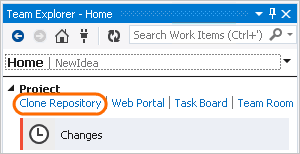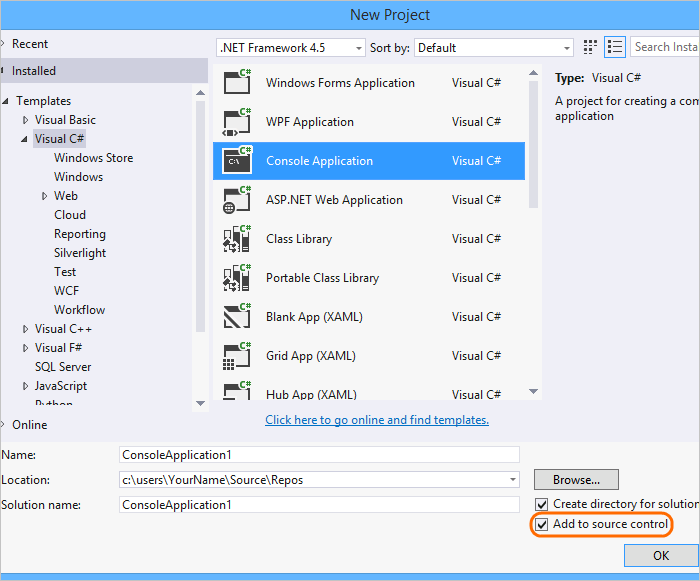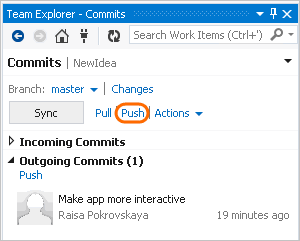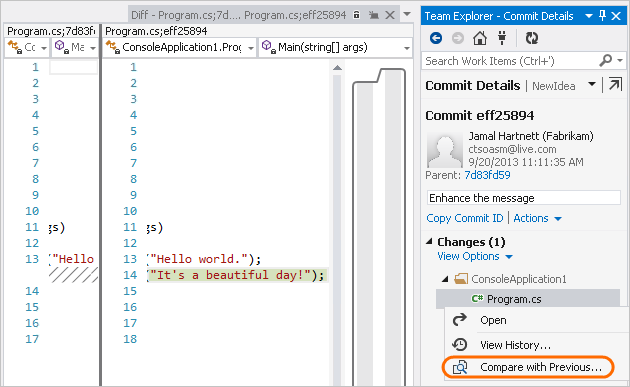Share your code with Azure Repos and Visual Studio
TFS 2017 | TFS 2015
Visual Studio 2019 | Visual Studio 2017 | Visual Studio 2015 | Visual Studio 2013
Share your Visual Studio solution with others by hosting your code in an Azure Repos Git repository. You can use Visual Studio to manage Azure Repos Git repositories or GitHub repositories. This article provides procedures for the following tasks:
- Add a project or solution to a local Git repository
- Publish your code to an Azure Repos Git repository or GitHub repository
- Review your code changes before publishing
- Link work items to your commits
- Commit and push updates
- Pull changes from the main branch of your repository
To clone a GitHub repository, get the clone URL as described in Cloning a repository.
For an overview of the Git workflow, see Azure Repos Git tutorial.
Prerequisites
To view code, you must be a member of an Azure DevOps project with Basic access or higher. If you aren't a project member, get added.
To clone or contribute to code, you must be a member of the Contributors security group or have the corresponding permissions.
To learn more about permissions and access, see Default Git repository and branch permissions and About access levels.
Note
Visual Studio 2019 version 16.8 and later versions provide a new Git menu for managing the Git workflow with less context switching than Team Explorer. Procedures provided in this article under the Visual Studio 2019 tab provide information for using the Git experience as well as Team Explorer. To learn more, see Side-by-side comparison of Git and Team Explorer.
Add a project or solution to a new local Git repository
The first step to sharing your Visual Studio solution with others using Git is to create a local Git repo for your code. If it's your first time using Visual Studio to connect to Azure Repos, see Connect to a project from Visual Studio for details.
Create a new local Git repo for your Visual Studio solution, by right-clicking the solution name in Solution Explorer, and then selecting Create Git Repository. Or, choose Add to Source Control on the status bar in the lower right-hand corner of Visual Studio, and then select Git. If you don't see these options, then your code is already in a Git repo.
Or, choose Git > Create Git Repository from the menu bar to launch the Create a Git repository window. If you don't see this option, then your code is already in a Git repo.
This step only applies to the Visual Studio Git version control experience: in the Create a Git repository window, choose Local only, verify the local path is correct, and then choose Create.
Team Explorer doesn't launch the Create a Git repository window, and assumes you want a local Git repo.
You've now created a local Git repo in the Visual Studio solution folder and committed your code into that repo. Your local Git repo contains both your Visual Studio solution and Git resources.
Publish your code
You can share your work with others by publishing your local Git repo to an Azure Repos Git repo.
Visual Studio 2019 version 16.8 and later versions provides a Git version control experience while maintaining the Team Explorer Git user interface. To use Team Explorer, uncheck Tools > Options > Preview Features > New Git user experience from the menu bar. You can exercise Git features from either interface interchangeably. Below, we provide a side-by-side comparison for publishing your code.
Note
One advantage of connecting to a project through Team Explorer is you gain access to the Work Items hub. For an overview of Team Explorer features, see Navigate in Visual Studio Team Explorer.
Visual Studio Git
- Connect to an Azure DevOps repo by right-clicking the solution name in Solution Explorer, and then selecting Push to Git service to launch the Create a Git repository window.
Or, choose Git > Push to Git service from the menu bar to launch the Create a Git repository window.
Open a browser and navigate to your Azure DevOps project by using a URL in the form of
https://dev.azure.com/<OrganizationName>/<ProjectName>. If you don't have a project yet, create one.In your Azure DevOps project, Create an empty Git repo without a README file. Copy the clone URL from the Clone Repository popup.
- In the Create a Git repository window, choose Existing remote and enter the repo clone URL from the previous step, and then choose Push. For more information on how to create a new Azure DevOps repo, see Create a new Git repo in your project.
- The Git Changes window shows a confirmation message that your code is now in an Azure DevOps repo.
Visual Studio Team Explorer
- In the Push to Azure Dev Ops Services section of the Synchronization view in Team Explorer, select the Publish Git Repo button.
- Choose your Azure DevOps account, organization, and repo name, and then select Publish Repository.
This step creates a new project in your Azure DevOps account with the same name that you selected for the repo. To create the repo in an existing project, select Advanced next to the Repository name, and then choose a project.
- Your code is now in a Azure Repos Git repository. You can view your code on the web by selecting See it on the web.
Review commit changes
It's good practice to review the code changes in your commit before publishing. Visual Studio provides a diff view that helps you see all the changes you've made since the previous commit.
Visual Studio Git
- To see what's changed in a commit, open the Git Repository window by choosing Git > Manage Branches from the menu bar.
- In the Git Repository window, select your branch, right-click the commit, and then choose View Commit Details to open the Commit window.
- In the Commit window, you can right-click on any file and select Compare with Previous to view the file changes made by the commit.
Visual Studio Team Explorer
- To see what's changed in a commit, go to the Synchronization page in Team Explorer, right-click on any commit, and then choose View Commit Details to open the Git Details window.
- In the Commit Details window, you can right-click on any file and select Compare with Previous to view the file changes made by the commit.
Link work items to your commits
As you develop your software, you can capture which commits support the completion of work items like Azure DevOps tasks or bug fixes. The audit trail of work items linked to commits lets your team understand how tasks and bugs were resolved.
Note
The #ID syntax is supported when you connect to an Azure Repos Git repository. If you connect to a GitHub repository, you can still link to work items, but must use the #ABID syntax, and have previously set up an Azure Boards-GitHub connection.
Visual Studio Git
You can link work items to commits by adding #ID into the commit message. For example, the commit message "Fix bug #12 in the reporting tools" would link work item 12 to the commit when the commit is pushed to Azure Repos.
Visual Studio Team Explorer
You can include work items in your commits through Related Work Items in the Changes view of Team Explorer.
You can also link work items to commits by adding #ID into the commit message. For example, the commit message "Fix bug #12 in the reporting tools" would link work item 12 to the commit when the commit is pushed to Azure Repos.
Push commit changes
As you write your code, your changes are automatically tracked by Visual Studio. When you're satisfied with your changes, you can save them in Git using a commit, and then push your commit to Azure Repos.
Visual Studio Git
- In the Git Changes window, enter a message that describes the changes, and then choose Commit All. Commit All commits unstaged changes and skips the staging area. You can choose to stage all files before committing by selecting the stage all + (plus) button at the top of the Changes section of the Git Changes window.
- To push your commit to Azure Repos, select the up-arrow push button.
Or, you can push your commit from the Git Repository window. To open the Git Repository window, select the outgoing / incoming link in the Git Changes window.
Or, you can choose Git > Push from the menu bar.
Visual Studio Team Explorer
- Open the Changes view of Team Explorer by selecting the Home button and choosing Changes. Or, select the pending changes icon
 on the status bar.
on the status bar.
- In the Git Changes window, enter a message that describes the changes, and then choose Commit All. Commit All commits unstaged changes and skips the staging area. You can choose to stage all files before committing by selecting the stage all + (plus) button at the top of the Changes section in the Git Changes window.
- To push one or more commits to Azure Repos, select Home and then choose Sync to open the Synchronization view in Team Explorer. Or, select the unpublished changes status bar icon (
 on the status bar.
on the status bar.
- In the Synchronization view, choose Push to upload your commit to the remote repo. If this is your first push to the repo, you'll see the message:
The current branch does not track a remote branch..., which lets you know that your commit was pushed to a new branch on the remote repo and that future commits pushed from the current branch will be uploaded to that remote branch.
Pull changes
You can keep your local branches in sync with their remote counterparts by pulling commits created by others. While you're working on your feature branch, it's a good idea to periodically switch to your main branch and pull new commits to keep it current with the remote main branch.
Note
Fetch and Pull links can be found in different views and in the Git menu on the menu bar. Those links all do the same thing—fetch or pull from the remote repo to the current branch of the local repo.
Visual Studio Git
- In the Git Changes window, you can check for the latest commits on the remote branch by using the down-arrow fetch link, then selecting the outgoing / incoming link to open the Git Repository window. Fetch downloads remote commits that aren't in your local branch, but won't merge them into your local branch. Fetched commits show up in the Incoming Commits section of the Git Repository window. You can double-click a fetched commit to view its file changes.
- Choose Pull to merge the fetched remote commits into your local repo. Pull performs a fetch and then merges the downloaded commits into your local branch.
Visual Studio Team Explorer
- In Team Explorer, select Home and choose Sync to open the Synchronization view.
- In the Synchronization view, you can preview the latest changes on the remote branch by using the Fetch link. Fetch downloads remote commits that aren't in your local branch, but doesn't merge them. Fetched commits show up in the Incoming Commits section of the Synchronization view. You can double-click a commit to view its file changes.
- Choose Pull to merge the fetched remote commits into your local repo. Pull performs a fetch and then merges the downloaded commits into your local branch.
FAQs
Q: Why does the sign-in page differ between the web portal and Visual Studio?
A: Your sign-in page depends on whether you used a Microsoft account or a work account with Azure DevOps. Always sign in with the username and password that you use for Azure DevOps.
Q: Can I use the Git command prompt with Visual Studio?
A: Visual Studio's Team Explorer and the Git command-line work great together. Changes to your repos made in either tool will be reflected in the other. Make sure to install the latest release of Git for Windows, which has tools to help you connect to your Azure DevOps Services/TFS repos.
See the Azure Repos Git tutorial and the command reference for additional help using Git from the command line.
Next steps
Set up a build for your code and learn more about using Git in the Azure Repos Git tutorial.




 on the status bar in the lower right-hand corner of Visual Studio.
This will create a new repo in the folder the solution is in and commit your code into that repo. You can also right-click your solution in Solution Explorer and choose Add Solution to Source Control.
on the status bar in the lower right-hand corner of Visual Studio.
This will create a new repo in the folder the solution is in and commit your code into that repo. You can also right-click your solution in Solution Explorer and choose Add Solution to Source Control.
 shows the number of unpublished commits in your local branch. Selecting this opens the Synchronization view in Team Explorer.
shows the number of unpublished commits in your local branch. Selecting this opens the Synchronization view in Team Explorer. shows the number of uncommitted file changes. Selecting this opens the Changes view in Team Explorer.
shows the number of uncommitted file changes. Selecting this opens the Changes view in Team Explorer. shows the current Git repo. Selecting this opens the Connect view in Team Explorer.
shows the current Git repo. Selecting this opens the Connect view in Team Explorer. shows your current Git branch. Selecting this displays a branch picker to quickly switch between Git branches or create new branches.
shows your current Git branch. Selecting this displays a branch picker to quickly switch between Git branches or create new branches. on the status bar in the lower right-hand corner of Visual Studio.
This will create a new repo in the folder the solution is in and commit your code into that repo.
on the status bar in the lower right-hand corner of Visual Studio.
This will create a new repo in the folder the solution is in and commit your code into that repo.
 shows the number of unpublished commits in your local branch. Selecting this will open the Sync view in Team Explorer.
shows the number of unpublished commits in your local branch. Selecting this will open the Sync view in Team Explorer. shows the number of uncommitted file changes. Selecting this will open the Changes view in Team Explorer.
shows the number of uncommitted file changes. Selecting this will open the Changes view in Team Explorer. shows the current Git repo. Selecting this will open the Connect view in Team Explorer.
shows the current Git repo. Selecting this will open the Connect view in Team Explorer. shows your current Git branch. Selecting this displays a branch picker to quickly switch between Git branches or create new branches.
shows your current Git branch. Selecting this displays a branch picker to quickly switch between Git branches or create new branches.






























































